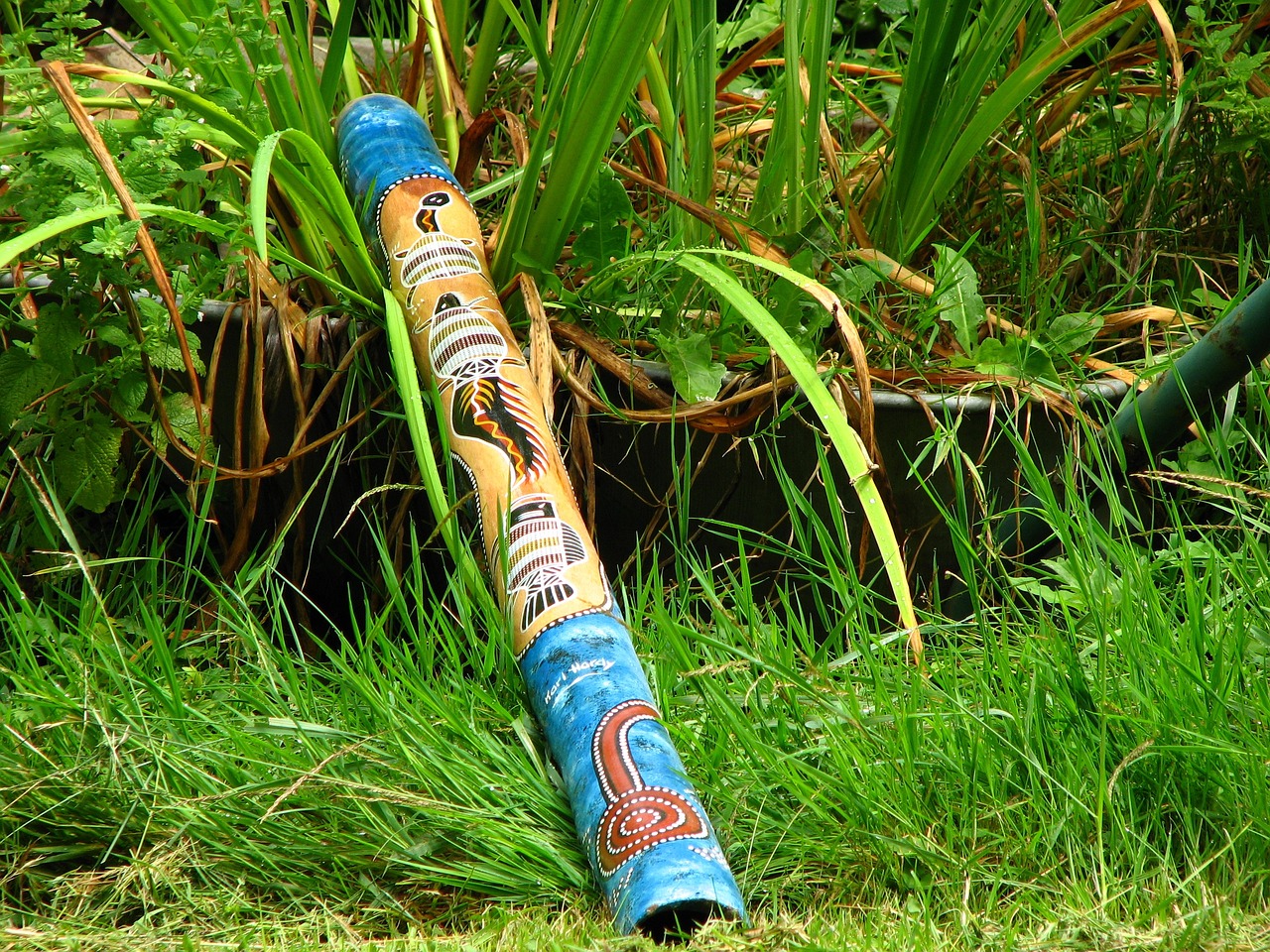The didgeridoos, a unique wind instrument originating from the Indigenous people of Northern Australia, holds profound cultural and spiritual significance. Dating back thousands of years, this ancient instrument has been an integral part of Aboriginal traditions, serving as more than just a musical device.
You might be wondering, are didgeridoos an ancient practice for spirituality? Yes! They play a key role in healing, cultural identity, and spirituality. Let’s explore how the didgeridoo has been used as a tool for spiritual practices and its impact on cultural and physical well-being.
1. The Origins and Spiritual Significance of the Didgeridoos
The didgeridoos is believed to have been used in Aboriginal culture for centuries, with some estimates suggesting it may have been in use for over 1,500 to 2,000 years. Traditionally crafted from naturally hollowed-out eucalyptus branches, the didgeridoo produces a deep, resonant sound that is said to mimic the natural sounds of the earth.
This sound is closely associated with “Dreamtime”—a central concept in Aboriginal spirituality that represents the creation and the spiritual essence of all things.
The instrument is not just a tool for creating music; it is a sacred object that connects the player with ancestral spirits and the land. When playing the didgeridoos, the musician is engaging in a spiritual practice that bridges the physical and spiritual realms.
It is believed that the sound of the didgeridoo carries the stories and wisdom of the ancestors, allowing the player to tap into the spiritual energy of the land and the universe.
2. Didgeridoos as a Tool for Storytelling and Cultural Connection
In Aboriginal culture, storytelling is a vital way of passing down knowledge, history, and traditions from one generation to the next. The didgeridoo plays an important role in these storytelling traditions. It is often played alongside other forms of expression, such as song, dance, and visual art, creating a rich and immersive cultural experience.
Storytelling and Community Bonding
The rhythms of the didgeridoo set the backdrop for storytelling, enhancing the narrative and creating a sense of unity among the participants. The sound of the didgeridoos is believed to mimic the elements of nature, such as the wind, animals, and water, strengthening the connection between humans and the natural world. Through this instrument, stories of creation, ancestral beings, and cultural values are shared and preserved.
Cultural Pride and Identity
The didgeridoo is not just an instrument; it is a powerful symbol of Aboriginal identity and pride. It represents the resilience and continuity of Aboriginal culture in the face of colonization and cultural assimilation.
By playing the didgeridoos, Aboriginal people reclaim their cultural traditions, asserting their right to exist and thrive as a distinct cultural group.
The instrument is often adorned with intricate designs and symbols that represent totems, Dreamtime stories, and other cultural elements. These designs add another layer of significance to the didgeridoos, making it a visual representation of the player’s connection to their heritage, ancestors, and the land.
3. The Role of the Didgeridoos in Spiritual Healing
The didgeridoo has long been celebrated for its therapeutic potential. In Aboriginal healing practices, the instrument is used to produce low-frequency vibrations that resonate with the body.
These vibrations are believed to help release energy blockages, facilitate emotional release, and restore balance within the body. The continuous drone of the didgeridoo, produced through the technique of circular breathing, creates a meditative and calming atmosphere that aids in spiritual and emotional healing.
Healing Vibrations and Emotional Release
The vibrations produced by the didgeridoos are also used to align the body’s energy centers or chakras. By placing the didgeridoos near the body, the sound waves penetrate deeply, helping to release tension and harmonize the body’s energy. This physical resonance can lead to profound relaxation, making it an effective tool for reducing stress and promoting overall well-being.
Techniques Used in Healing Practices
One of the key techniques used in playing the didgeridoo is circular breathing, which involves inhaling through the nose while simultaneously exhaling through the mouth. This allows the player to produce a continuous, uninterrupted sound, which is essential for maintaining the healing vibrations. This uninterrupted flow helps the listener enter a meditative state, providing a space for spiritual growth and emotional release.
Skilled players also use different rhythms and pitches to evoke various emotional responses. For example, slower rhythms may be used to promote relaxation, while faster tempos can energize and uplift the listener. The adaptability of the didgeridoos makes it a versatile instrument in healing practices, allowing practitioners to respond to the specific needs of individuals or groups.
4. Didgeridoos in Meditation and Spiritual Awakening
The didgeridoo is also used as a powerful tool in meditation and spiritual practices. The deep, resonant tones of the instrument help create a tranquil atmosphere, facilitating a deep state of relaxation. When used in meditation, the didgeridoo’s sound synchronizes with the listener’s breath, leading to a heightened state of awareness and spiritual connection.
Incorporating the Didgeridoo in Meditation
Incorporating the didgeridoo into meditation practices enhances the experience by providing a sonic focus that calms the mind and deepens the connection to the present moment. The rhythmic sound of the didgeridoo helps to quiet the mind’s chatter, allowing individuals to fully immerse themselves in the meditative state. This sense of immersion can lead to a profound experience of inner peace and clarity.
Playing the didgeridoo as part of a meditation practice also serves as a form of self-exploration. The sound vibrations help release stress, tension, and negative energy, providing a pathway for spiritual awakening and personal growth. Through the didgeridoos, individuals can explore new realms of consciousness and connect with the ancient wisdom of the Aboriginal culture.
5. Physical Health Benefits of Playing the Didgeridoo
In addition to its spiritual and emotional benefits, playing the didgeridoo has been found to improve physical health, particularly respiratory function. The technique of circular breathing, which is essential for playing the didgeridoos, helps expand lung capacity and improve breathing control. This makes the didgeridoo an effective tool for enhancing respiratory health and has been shown to provide relief for conditions such as asthma.
Improving Respiratory Health
The deep, controlled breaths required to play the didgeridoo help strengthen the respiratory muscles, clear respiratory passages, and promote a greater sense of well-being. The physical act of playing the didgeridoo not only benefits the lungs but also encourages relaxation, reduces stress, and supports overall physical health.
Physical Resonance and Healing
The physical vibrations produced by the didgeridoo have a therapeutic effect on the body. When the instrument is played near or against the body, the sound waves resonate within, helping to release muscular tension and improve circulation. This type of sound therapy can be particularly effective in promoting physical relaxation and easing pain.
The didgeridoo’s ability to create low-frequency vibrations is thought to help harmonize the body’s energy fields. These vibrations help break up stagnant energy and promote a feeling of balance and harmony within the body. For many, the experience of receiving didgeridoos sound therapy is described as being enveloped in a soothing, healing aura.
6. The Didgeridoo as a Symbol of Connection to Nature
The didgeridoo is deeply connected to the land and the natural world. Aboriginal people believe that the instrument has the power to communicate with the spirits of the land, the animals, and the elements.
The sounds produced by the didgeridoo are said to mimic the voices of nature—such as the wind, water, and wildlife—allowing the player to engage in a spiritual practice that strengthens their bond with the environment.
Playing the didgeridoo is a way of honoring the land and its spiritual essence. The connection to nature is further reflected in the crafting of the instrument, which is traditionally made from eucalyptus branches hollowed out by termites. The process of selecting and crafting the didgeridoo is done with great care and respect for the natural world, reinforcing the deep connection between the instrument, the land, and the spirit.
7. Didgeridoo in Ceremonies and Community Practices
The didgeridoo has been used in Aboriginal ceremonies for generations, playing a crucial role in rituals and community gatherings. It is often used to accompany traditional dances and ceremonies, providing a rhythmic foundation that supports the ceremonial activities. The sound of the didgeridoo helps participants enter a trance-like state, facilitating a spiritual connection and enhancing the overall experience of the ceremony.
Role in Ceremonial Practices
In ceremonies, the didgeridoo serves as a bridge between the physical and spiritual realms, allowing participants to connect with their ancestors and the Dreamtime. The communal aspect of these ceremonies, where the didgeridoo is played alongside other forms of expression like song and dance, fosters a sense of belonging and unity within the community.
Supporting Spiritual Growth in the Community
The didgeridoo is not only a personal tool for spiritual exploration but also plays a significant role in community well-being. The act of gathering for ceremonies and sharing the sound of the didgeridoo strengthens communal bonds and reinforces cultural identity. It serves as a reminder of the shared history, traditions, and spiritual beliefs that bind the community together.
The didgeridoo’s role in community practices highlights its importance as a cultural and spiritual symbol. It is through the sound of the didgeridoo that the Aboriginal people connect with their heritage, preserve their traditions, and continue to pass down their spiritual knowledge to future generations.
Final Words
The didgeridoo is far more than just an ancient musical instrument; it is a profound spiritual tool that has played an essential role in Aboriginal culture for thousands of years. Through its deep, resonant tones, the didgeridoo connects individuals to the land, their ancestors, and the spiritual world. It serves as a bridge between the physical and spiritual realms, facilitating healing on multiple levels—physical, emotional, and spiritual. In this content, I answered: “Are didgeridoos an ancient practice for spirituality?”. Stay tuned for more information on it!


